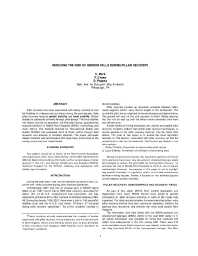Mining Publication: Reducing the Risk of Ground Falls During Pillar Recovery
Original creation date: December 2003
Pillar recovery has been associated with nearly one-third of roof fall fatalities in underground coal mines during the past decade. Safe pillar recovery requires global stability and local stability. Global stability is addressed primarily through pillar design. The local stability risk factors include cut sequence, the final pillar stump, supplemental supports (timbers versus mobile roof supports), roof bolting, and many others. The National Institute for Occupational Safety and Health evaluated each of these factors through field research and analysis of accident statistics. This paper discusses design methods and technologies that have been transferred to the mining community and implemented.
Authors: C Mark, DM Pappas, FE Chase
Conference Paper - December 2003
NIOSHTIC2 Number: 20026085
SME preprint 03-137. Littleton, CO: Society for Mining, Metallurgy, and Exploration, Inc., 2003 Dec; :1-9
See Also
- Analysis of Pillar Design Practices and Techniques for U.S. Limestone Mines
- Assessment of Stable and Failed Pillars in Underground Limestone Mines
- The Effects of Roof and Floor Interface Slip on Coal Pillar Behavior
- The Forgotten Denominator: Pillar Loading
- Multiple Seam Mining Interactions: Case Histories from the Harris No. 1 Mine
- Multiple-Seam Mining Interactions: Case Histories from the Harris No. 1 Mine
- Pillar Design and Strategies for Retreat Mining
- Pillar Design Issues for Underground Stone Mines
- Sizing of Final Stumps for Safer Pillar Extraction
- The Unpredictable Life Cycle of a Coal Pillar
- Page last reviewed: 9/21/2012
- Page last updated: 9/21/2012
- Content source: National Institute for Occupational Safety and Health, Mining Program


 ShareCompartir
ShareCompartir
